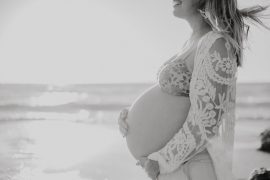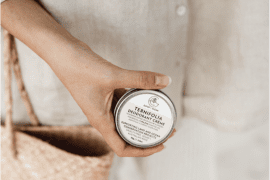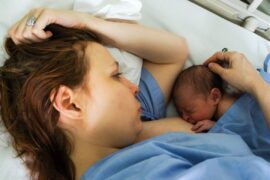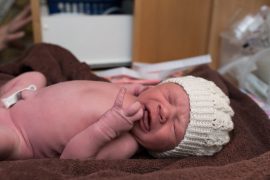The fight or flight hormones- also called catecholamines (pronounced cat-e-kol-a-meens), or CAs- can counteract oxytocin’s beneficial effects on the mother’s uterus during labour and after the birth. However they do have a positive role to play in the second stage of labour, which is when birth actually occurs.
Early in second stage, when the laboring woman’s cervix is fully open but the urge to push is not yet strong, a woman can feel the need to rest for some time. This is known as ‘transition’ – or the ‘rest and be thankful’ time. After this, she may quite suddenly experience the dry mouth, dilated pupils and sudden burst of energy that are all characteristic of high levels of CAs.
This burst of CAs gives a mother the energy to push her baby out efficiently; when unmedicated, women usually want to be upright at this time. Some traditional cultures have used this fight-or-flight effect to help women having difficulty with the delivery by surprising or shouting out at this stage, triggering a rapid birth. Threats of a cesarean or forceps delivery have been known to trigger this CA reflex for modern women.
CA levels drop quickly after the birth, which can make a mother may feel cold or shaky. At this stage a very warm atmosphere is essential to keep CA levels low, and to allow oxytocin to work effectively to prevent bleeding.
The other major birthing hormone, prolactin, is most noteworthy for its effects after the birth. Prolactin is the major hormone of breast milk synthesis. Suckling by the newborn baby increases prolactin levels; early and frequent suckling from the first days makes the breast more responsive to prolactin, which in turn helps to ensure a good long-term supply of milk.
When prolactin is combined with oxytocin, as it is soon after birth and during breastfeeding, it encourages a relaxed and selfless devotion to the baby that contributes to a mother’s satisfaction and her baby’s physical and emotional health.
Like the other hormones, prolactin has effects on emotion and behaviour. Prolactin helps us to put our babies needs first in all situations, and increases our vigilance, keeping us watchful and alert for our baby’s wellbeing. When prolactin is combined with oxytocin, as it is soon after birth and during breastfeeding, it encourages a relaxed and selfless devotion to the baby that contributes to a mother’s satisfaction and her baby’s physical and emotional health.
Beta endorphin (pronounced beet-a en-door-fin) is one of the endorphin hormones that are released by the brain in times of stress or pain, and is a natural equivalent to painkilling drugs like pethidine.
During labour, beta-endorphin helps to relieve pain, and contributes to the “on another planet” feeling that women often experience when they labour without drugs. More poetically, some cultures say that the labouring woman goes out to the stars to collect the soul of her baby and bring it back. Levels of beta-endorphin are reduced when drugs are used for pain relief.
Very high levels of beta-endorphin can slow labour by reducing oxytocin levels, which may help to ‘ration’ the intensity of labour according to our ability to deal with it. Moderate levels of beta-endorphin help us to deal with pain in labour, as well as encouraging us to follow our instincts. As part of the hormonal cocktail after birth, beta-endorphin plays a role in bonding between mother and baby, who is also primed with endorphins from the birth process.
Beta-endorphin also switches on learning and memory, perhaps explaining why we often remember our labour and birth in such amazing detail. Like oxytocin, endorphin hormones can induce euphoria and are also released during lovemaking and breastfeeding. In fact, endorphins are actually present in breast milk, which explains the pleasure that babies can get after a breastfeed. After a natural labour, the new mother has high levels of beta-endorphin in her early milk, helping her baby with the stressful transition to life outside the womb.
Like oxytocin, endorphin hormones can induce euphoria and are also released during lovemaking and breastfeeding. In fact, endorphins are actually present in breast milk, which explains the pleasure that babies can get after a breastfeed.
So there you are, at the door, with your bag in your hand and a strong contraction. You remember the oxytocin and endorphins, which you also carry with you, and with your next relaxed breath, you breathe out all of your fear and tension. You’ve packed your new nursing bra, and you know that prolactin will come to your aid as well. As you take a last look around the house, you notice your cat.
She’s lying down as her kittens attach to her nipples, and as you catch her eye, she winks at you.
Dr Sarah Buckley is a NZ-trained GP, also trained in GP obstetrics. She is the author of the internationally best-selling book Gentle Birth. Gentle Mothering and the scientific report Hormonal Physiology of Childbearing, published with Childbirth Connection (US) .Sarah is also the mother of four children, all naturally born and naturally raised, now in their teen years and beyond. Sarah is currently combines mothering with her work as a writer and lecturer on pregnancy, birth and parenting, and is also a PhD candidate at the University of Queensland in Brisbane, Australia. For more of her work, see www.sarahbuckley.com










